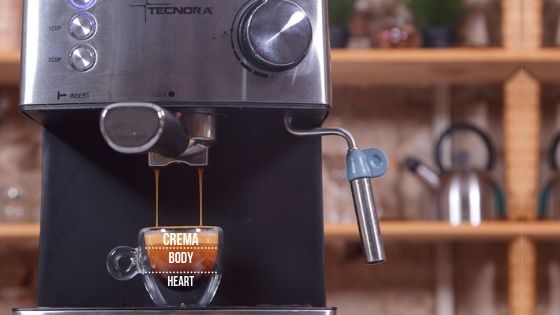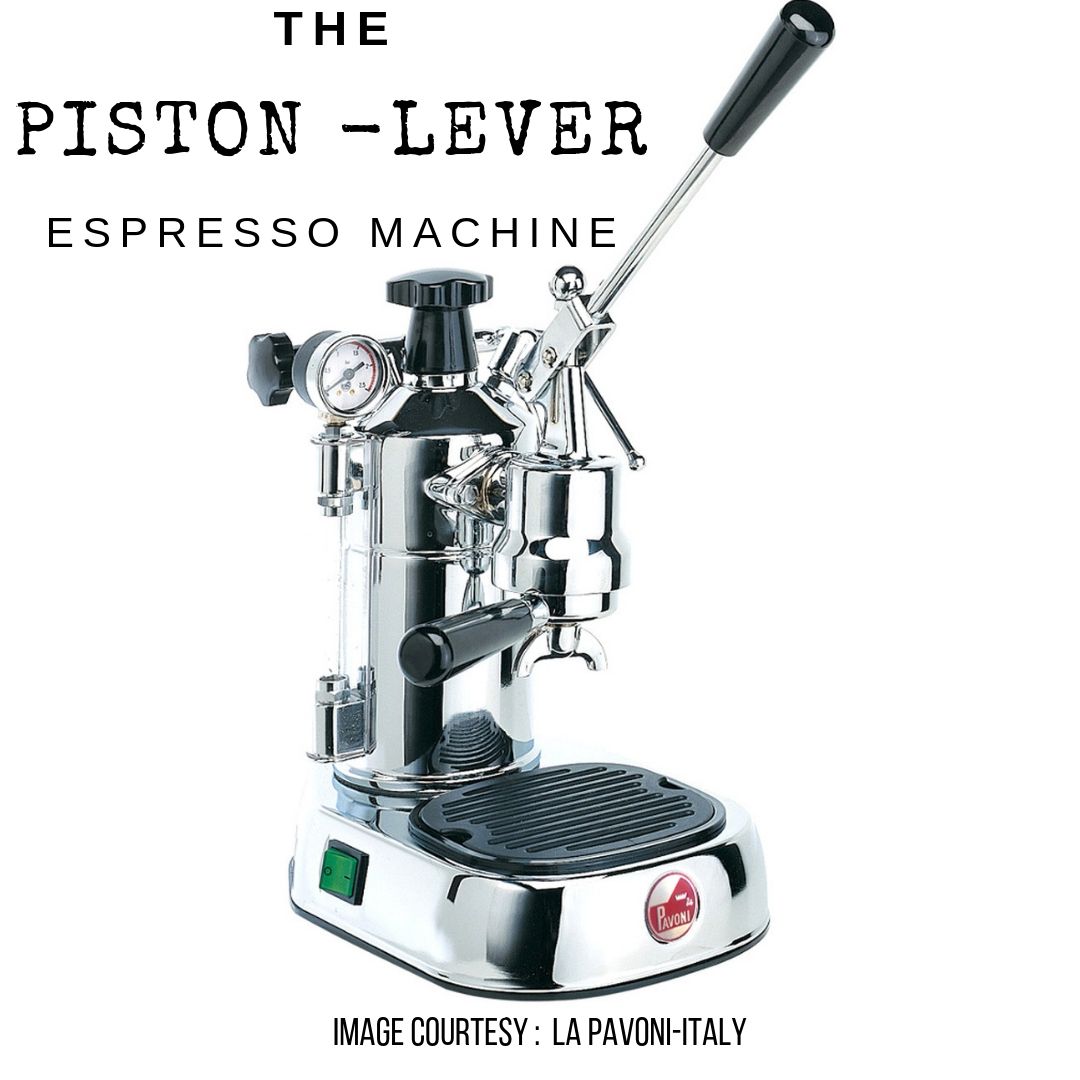
To fully understand the difference between semi-automatic and fully automatic espresso machines, we need to go back in history and look at the innovations that triggered iterations and ultimately became industry standards.
Trust us. It’s an interesting journey, one that will prepare you to make the right choice when you’re ready to indulge in some serious coffee-shop-style experiences in your own home.
The lineage
The espresso machine we know today is a descendant of the spring-piston-lever machine patented by Achille Gaggia in Italy back in 1947.
Gaggia’s espresso machine was a wonder of mechanical engineering, itself a descendant of Luigi Bezzara’s machine.
Bezzara, in turn, tweaked the original patented design by Angelo Moriondo.
Gaggia’s machine did for coffee lovers what the gramophone did for music lovers: it drove them into a frenzy.
These revolutionary machines turned coffee-shop baristas into performing artists. They played the levers like virtuosos, extracting espresso shot after shot to wide-eyed eager customers. They never seemed to get enough of the heady aroma of freshly brewed espresso.
 The timing
The timing
Back in the day, the brewing of an espresso shot was truly an art. The barista had to carefully master the algorithm of two key processes: pressure and timing.
It took lots of practice to master the knack of shot timing.
The knack was about a process of extracting a shot of espresso in about 25 to 30 seconds by deftly applying pressure to the lever by hand and controlling the flow in one smooth pull.
The goal of the ‘Maestro Barista’ or the Master Barista in Italian, was to prepare a shot visually distinct in appearance, showcasing all the three elements of a perfect espresso shot-
The body, the heart and the crown of crema.
The reality
The present-day reality is not so bad. As technology gets better and better, the machines and gadgets that serve us become more and more refined. Today, most of the heroics required of yesterday’s baristas are taken care of by technology.
Now the only way you can impress someone is by ditching instant coffee and going for freshly brewed coffee from an espresso machine.
As steam espresso machines don’t come with a solenoid valve pump which takes care of the pressure required for the pull, we’re not going to spend time on them. Instead, we’re going to focus on pump-driven espresso machines.
Both semi-automatic and fully automatic machines have an electric motor-driven pump that replaces the force required by hand in the earlier piston-lever machines. This pump forces hot water through the coffee grounds to brew an espresso shot: it takes care of the pull.
Almost all espresso machines come with a steam wand for frothing milk for your cappuccinos and lattes. So what then is different? The major difference between semi-automatic and fully automatic machines is the mechanism that controls the shot timing.
The semi-automatic espresso machine
An electric pump replaces the piston
As we’ve already mentioned, a semi-automatic espresso machine has an electric motor-driven pump that connects the boiler to the water tank.
Every time you press the pump button for your espresso shot, water is drawn from the tank and forced through the boiler into your coffee grounds which are neatly packed into a puck in the portafilter basket.
In commercial machines, the boiler has a larger capacity and therefore already holds an adequate amount of water which is heated up as soon as you turn on the machine.
For every subsequent espresso shot, fresh room-temperature water from the tank is drawn from the pump into the boiler, bringing the temperature down, but immediately firing up the heating coils to compensate for the temperature loss. It’s the same principle as the instant water heaters we use in our homes.
User-managed shot timing
The machines are only semi-automatic because the shot timing is manual.
You flick the pump switch to start the flow and flick it again to turn it off when you feel the desired quantity of espresso has collected in your cup.
Some people prefer having this control over their shots and often ditch fully automatic machines for their lack of customisation.
But fully automatic machines with a PCB control will let you program the shot timing according to your preference, as we’ll talk about in a minute.
Some coffee shops have commercial semi-automatic machines, but most prefer fully automatic ones as they have heavy customer traffic and want to free up their baristas to do something else in the 25 seconds they’d have needed to monitor the espresso shot.
Domestic semi and fully automatic espresso machines work in a similar way as commercial machines, only the overall footprint and boiler capacity differs.
The fully automatic espresso machine
A micro-computer is added for automation
Fully automatic espresso machines have all the same features as semi-automatic machines but with an additional PCB control.
Electronics lodged inside these machines take care of the shot timing.
A flow meter measures the flow of water into the group head, passes this data to the electronics or the mini internal computer, which on the basis of a pre-programmed timer, shuts the pump off automatically.
Human intervention is required only to turn the pump on. The pump turns off automatically.
The benefit of the fully automatic system is that for a given roast profile of coffee powder, once you’ve determined your espresso shot quantity, you’ll get perfect results every time.
The re-programming of the timer is child’s play. If you change your coffee powder or want to try a special roast you picked up from an artisan roaster, you can always adjust the timing to your liking.
User-programmable shot timing!
Since we’re on the subject of shot timing, it makes sense to talk about industry standards.
It’s generally accepted that a single shot of espresso is a 30-ml shot.
But this isn’t carved in stone. It’s all a matter of preference. You may choose to have your shot a bit larger, say 40 or even 50 ml.
Several factors are at play when it comes to the taste profile: bean quality, type of roast, and even the quality of the water in your area. But it is true that all the oils and flavour profiles of an espresso shot are contained in the first 30 ml or so.
More automated options
Neither semi-automatic nor fully automatic machines have done away with human intervention. Both require you to fill and tamp the coffee powder into the portafilter basket.
Except, of course for the capsule -technology fully automatic machines in which a preportioned amount of coffee, tamped and preserved in capsules is popped into the machine and then with the press of a button, you have an espresso.
Or, you go in for a super-automatic bean to cup machine. These do all the grinding, tamping, and brewing at the touch of a button and also have a milk frother or a steam wand for frothing up milk for your cappuccinos and lattes.
A quick note on another variable-pressurised or non-pressurised filter baskets. Espresso machines can come with a choice of either of the two kinds of baskets. Most domestic machines come with standard non-pressurised baskets. This requires some further reading and we suggest you do have a quick look-up on the difference between pressurised and non-pressurised baskets
The conclusion
For a true coffee-shop-style experience, you need a pump-driven espresso machine. This is a given. There are no shortcuts.
If you’re the type who needs a coffee to wake up, then you can ditch the pit-stop to the coffee shop on your way to work and take your own coffee flask with you in the morning.
Great coffee prepared in your own home, with the aroma nudging you to go out and greet the day with a smile.
And of course, it’s great for that lazy weekend as well.
The math
A semi-automatic machine costs upwards of a US$100/- and is a great start to your coffee journey.
A fully automatic machine is usually the second espresso machine purchase for most people. This is stage two on their coffee journey. Prices begin at US$ 200/-. If you’re willing to pay a premium for convenience, a fully automatic espresso machine is the way to go.
Final notes:
If you’ve no time and cannot function without coffee, then you need a super-automatic machine or a capsule driven machine. There’s much debate in coffee circles on the pitfalls of going for a super-automatic machine; many coffee experts find that these machines ultimately compromise the coffee experience. But it’s your coffee, your machine, your decision.
Here’s one such article we thought is worth sharing…
Are Super Automatic Machines Worth Buying?-Wired.com
